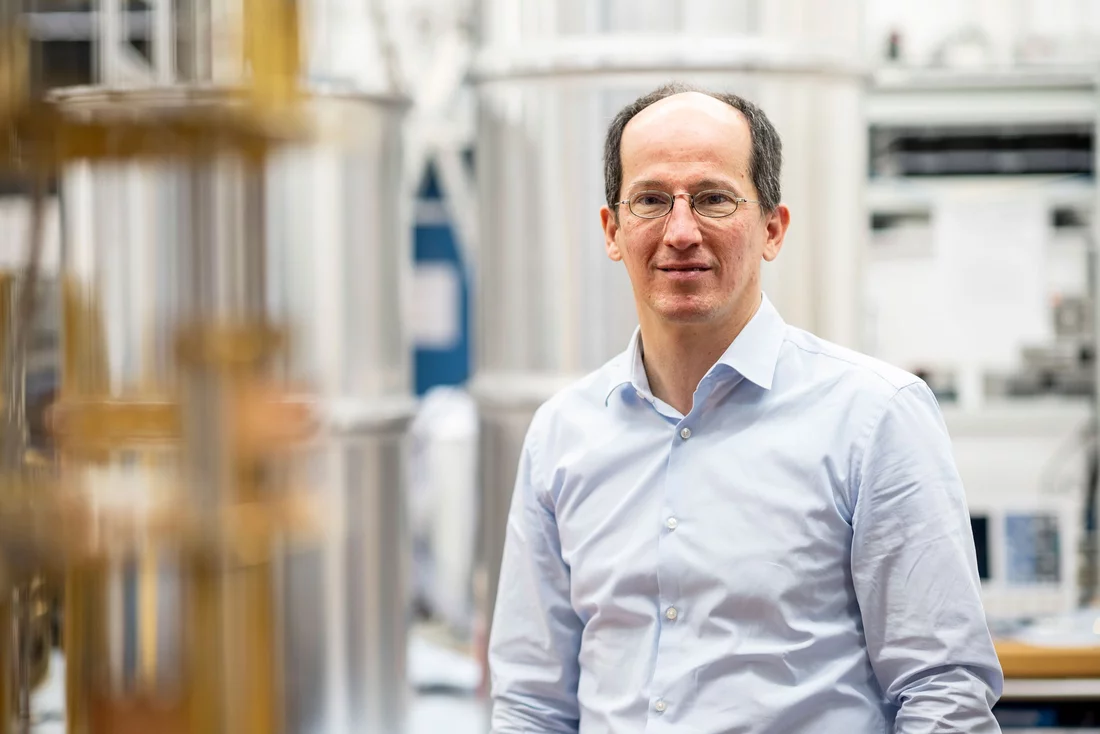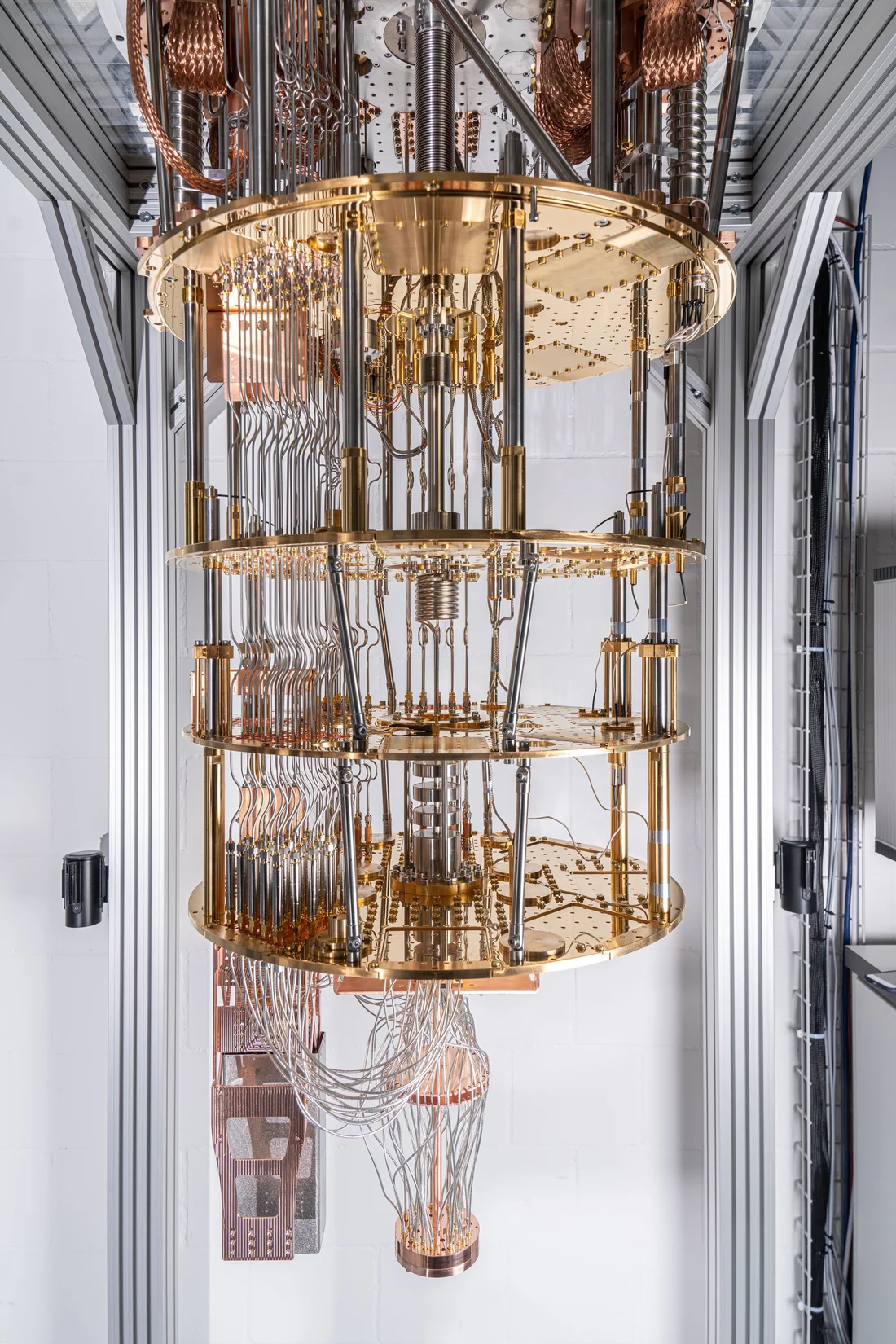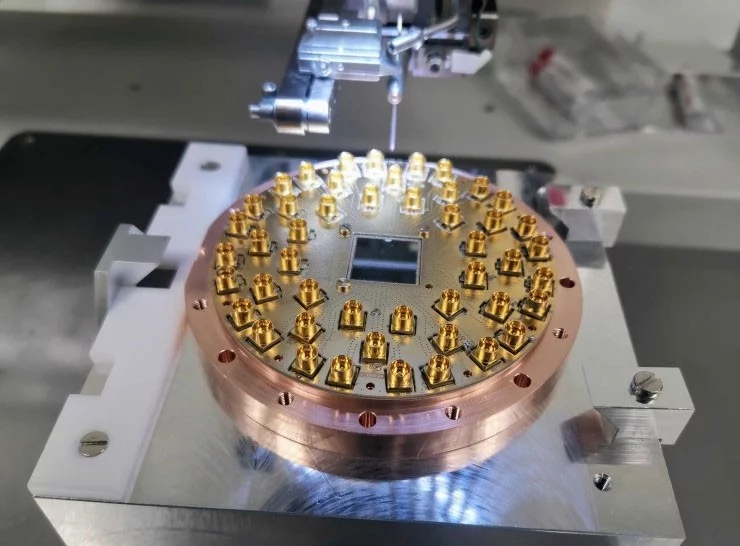Eight months after its inauguration, things are moving quickly forwards in the ETHZ-PSI Quantum Computing Hub. Andreas Wallraff and his team from the Quantum Device Lab at ETH Zürich, who are developing superconducting circuits for quantum computing, recently measured the first qubit on a 17-qubit device. The ETHZ-PSI Quantum Computing Hub focuses on two technologies: ion traps and superconducting circuits. The hub intends to leverage strengths at PSI in large-scale infrastructure to achieve a goal of creating 100 qubit devices. In an interview, Andreas Wallraff tells us more about the recent progress from the superconducting circuit side of things.
Andreas, how is the new lab coming along?
We started installing equipment in May in our freshly renovated building on the PSI campus. A major task has been the installation of two big dilution refrigerators, which cool our circuits close to absolute zero. These are essential for the superconducting components of the circuits to reach their superconducting phase and to reduce thermal noise that would otherwise hinder qubit operation.
You call them refrigerators? They sound more like heavy duty deep freezers.
Well, yes, that is the technical term. They are cryogenic systems, which cool our superconducting circuits to a chilly 10 milli-Kelvin. In the photo the cryostat is shown in its open fashion; it’s a bit like a Russian doll. There is a vacuum chamber on the outside (which in the photo has been removed), and then layers of insulation, radiation shields and magnetic shielding from the environment. The device sits in the middle of this, connected via the cables going upwards and out of the cryostat to the electronics.
And tell us more about the very special doll nested in the centre.
The current device that we’ve installed is one of our next-generation devices and one of the largest chips available in Europe. It’s based on a silicon substrate with superconducting metallisation, using niobium and aluminium.
The active elements – which correspond to the transistors in a conventional circuit – are the Josephson junctions. These are made by sandwiching a less than a nanometer thin oxide between two layers of superconducting aluminium. This forms a tunnel junction, whereby paired electrons from one layer of the superconductor can tunnel through the electrically insulating oxide to the other layer. These Josephson junctions are what turns a superconducting circuit into a qubit. In our design, each physical qubit uses two Josephson junctions and there are 17 qubits on the device.
The sample manufacturing takes place in a multistep process between different cleanrooms at ETHZ. Installation of a superconducting chip with many qubits requires rather a lot of complex electronics, cabling and signal conditioning components. This all came together at the end of last year, and now we have made our first measurements.
Wow, impressive progress. What exactly did you measure?
We made two measurements that tell us that the qubits are alive and functioning, and let us assess how well they work: the energy relaxation time and the spin-echo time.
With quantum computers, it is possible to store information, but not for an arbitrarily long period of time. The qubit naturally sits in its ground state, which we can represent with a zero. We can initialise this qubit by exciting it - then it becomes a 1. However, naturally over time it will decay back to a zero – it’s a simple principle of quantum mechanics, known as spontaneous emission. We want those 1s to stay as 1s for as long as possible. And so, as a basic assessment of the quality of our qubits, we measure the energy relaxation time: the average time it takes for a 1 to decay to a zero.
In representing classical information, we use 0s and 1s, with nothing in between. In quantum computing, there are the 1s and 0s. But superpositions are also possible: a qubit can be 0 and 1 simultaneously. We describe these superpositioned states as 0+1 or 0-1. The spin-echo time looks at how long it takes for the 0+1s turn into 0-1s.
We measured an energy relaxation time of 40 microseconds and a spin-echo time of 30 microseconds. Both of these are respectable times, telling us that the qubits are working!
So, what do you do when these 1s turn into 0s?
Indeed, that is one of the major challenges of quantum computing! As is what to do when 0+1 turns into 0-1. In a quantum computer, we need to deal with both of these problems using an error correction approach. This is the subject of a recent breakthrough we had, which can be read in a press release from ETHZ.
Our approach to error correction is the reason our chip contains 17 physical qubits: this is not a random number. Nine of the qubits are arranged in a three-by-three matrix and form a logical qubit: a single error-corrected qubit with computational capabilities. The other eight physical have the job of detecting errors.
And when can we use it?
I’m afraid you’re going to have to wait a bit longer for that. A number of start-ups and big companies such as IBM make their quantum chips available for outside users – typically scientists but also very early industry adopters – to play with. Although this would be possible for us, at the moment, this is not our focus. Our focus is to improve quantum computing hardware.
Our goal at the Quantum Computing Hub is to make larger devices, with a target of going towards 100 qubit devices – and then beyond. And this is where PSI, with its experience in large-scale scientific projects, comes in. When you look at the photo of our 17-qubit device in the cryogenic system, and the amount of electronics, cabling and connectors that are required, it becomes clear that going towards bigger devices becomes a significant engineering challenge. One example, which is just a tiny piece in the puzzle, is that every microwave cable requires a very special infrared filter to shield the experimental setup from external electromagnetic radiation. These must be custom-made. We used to make these filters ourselves; in the current setup, there are approximately 150 of these filters. We have now transferred the knowhow to the PSI electronics and machine shops so that they are able to produce them. Now based at PSI, we are really looking forward to benefitting from a greater continuity and ability to address these engineering challenges.
Text: Paul Scherrer Institute / Miriam Arrell
© PSI provides image and/or video material free of charge for media coverage of the content of the above text. Use of this material for other purposes is not permitted. This also includes the transfer of the image and video material into databases as well as sale by third parties.
Contact
Prof. Dr. Andreas Wallraff
Professor for Solid State Physics
ETH Zürich Department of Physics
Otto-Stern-Weg 1
8093 Zürich
Switzerland
Telephone: +41 44 633 75 63 / +41 44 633 23 35 (Sec.)
Email: andreas.wallraff@phys.ethz.ch
Twitter: @AndreasAtEth
Further Information
Quantum Computing Hub | Quantum Computing Hub | Paul Scherrer Institut (PSI)



